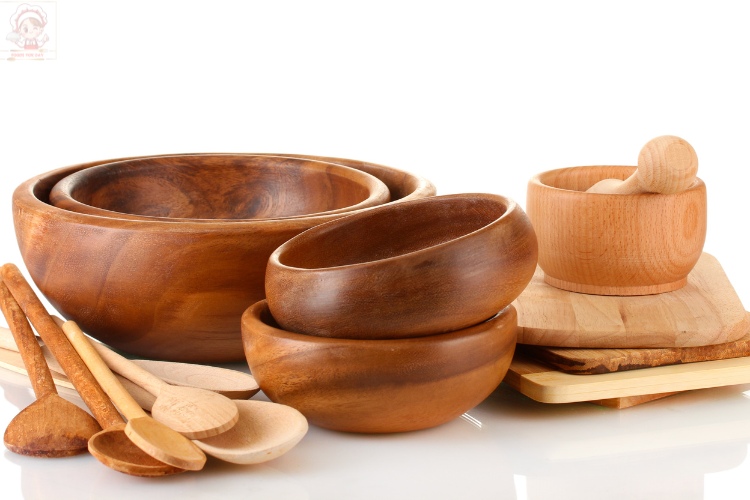Choosing the right materials is very important when you’re buying kitchen utensils. Which enduring material can be used a lot and last? Wood responds to the requirement, so that is a fantastic choice for your kitchen. It can handle the heat from hot water, ovens, and surfaces with ease. It is not only strong and durable, but also completely natural and free from any harmful chemicals.
Plus, it looks absolutely amazing! On top of all that, wood offers plenty of benefits that plastic and other materials just can’t match. Between so many different types of wood out there, it is not easy to find out which one is best for your cooking utensils. So, which wood should you go for?
We separate wood into two kinds: softwoods and hardwoods. What is the difference? Let’s go with Foods for Day to know the best type of wood for cooking utensils.
1. Best woods are use for kitchen utensils
1.1. Soft Maple
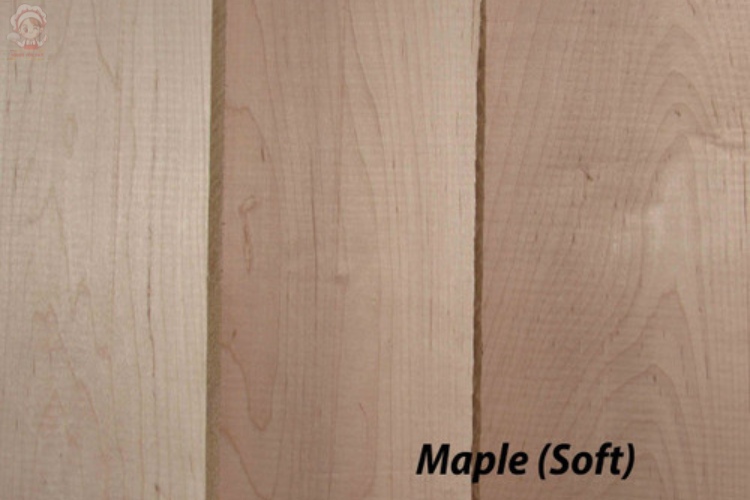
- Making wooden spoons and other wooden cooking utensils using maple wood is a fantastic choice because it’s safe and doesn’t release any harmful substances. This particular wood type has a straight grain and is impressively thick, making it highly durable even in the busiest kitchens.
- Maple wood has an inviting, smooth texture and a lovely light color. It comes from eastern Canada. As the tree matures, its bark gradually transitions from brownish-red to light gray or white. For generations, maple has been a popular material for cooking spoons because it doesn’t react with food, ensuring no unwanted flavors are imparted.
- What’s more, soft maple is resistant to moisture and remarkably easy to shape and carve. Its moderate hardness strikes a perfect balance, allowing your spoons to maintain their functionality while protecting your valuable cookware from unsightly scratches.
Related post:
- Best organic bamboo cooking utensils: cutlery and spoon set
- Top metal utensils are good for health in the kitchen
- List of 70+ Kitchen Utensils: Tools, Equipment, and Gadgets
- What are kitchen utensils? Kitchen tools: names and uses
1.2. Hard Maple

- This particular wood variety, known as sugar maple or hard maple, is widely utilized in North America. It boasts a delightful natural light shade and can be enhanced with a polished or sealed finish to achieve a bright and glossy appearance.
- When it comes to crafting wooden spoons and ladles, maple wood is an exceptional option. Its tight grain provides remarkable resistance against scratches on your cookware. These utensils will outlast other woods with minimal maintenance, although occasional cleaning may be necessary to preserve their impeccable look.
- Chefs highly favor hard maple spoons due to their renowned strength and ability to withstand the rigors of everyday use. Additionally, they do not impart any flavor or taste to the food. So they perfect for preparing and serving of dishes.
Video about best wood for wooden utensils
1.3. Black Walnut wood
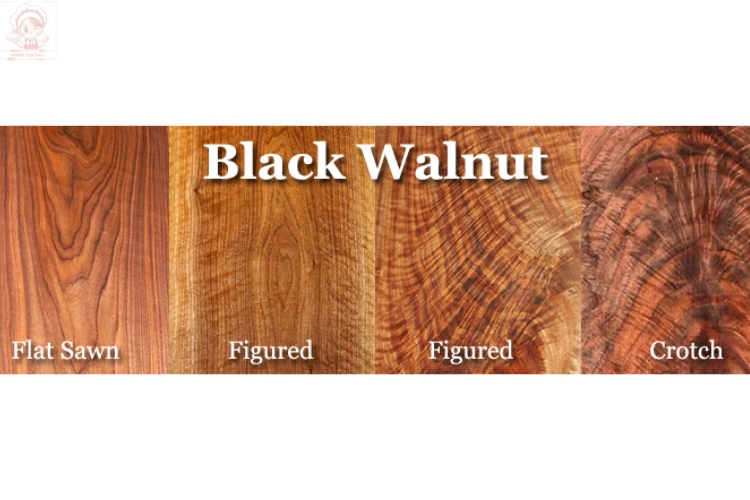
- Incorporating black walnut wood into your home for furniture, cookware, or flooring creates a captivating and unique ambiance. Whether it takes center stage or serves as a subtle accent, it effortlessly captures attention.
- Black walnut is an excellent option for crafting designer pieces that can be cherished for years to come, thanks to its durability, undeniable beauty, and versatility.
- Maintaining walnut wood is easy because it can be resistant to dents, scratches, and various forms of damage compared to many other wood varieties.
1.4. Chestnut wood

- Chestnut, a type of hardwood, stands out for its warm and inviting golden-brown shade and unique straight-grain patterns. Renowned for its relative softness and ease of shaping and handling, it is a popular selection for kitchen utensils. Its lightweight construction and comfortable grip make it particularly well-suited for crafting spoons, spatulas, and ladles.
- When searching for a lightweight and user-friendly material for your cooking utensils, chestnut is an excellent choice. Its warm hue and prominent straight-grain patterns not only offer aesthetic appeal but also make it a cost-effective alternative compared to other hardwood options.
1.5. Olive Wood
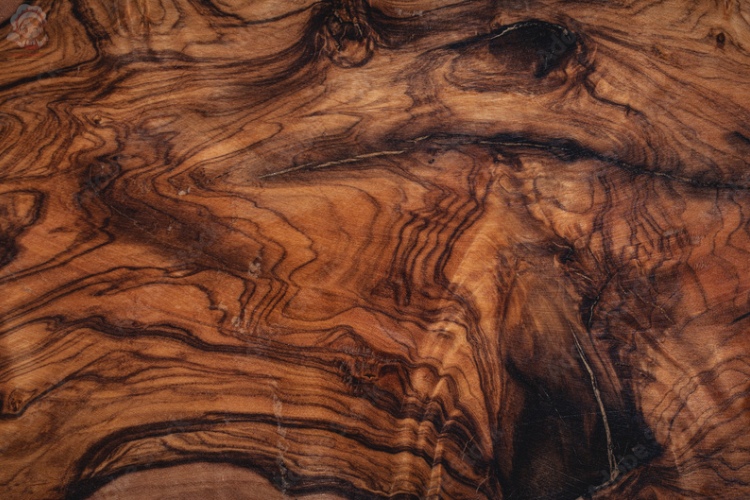
- Olive wood is a stunning option to enhance your kitchen with its captivating designs that add a touch of vintage elegance. What sets olive wood apart from other types is its smooth texture without noticeable grains.
- Not only does olive wood have visual appeal, but it also offers a neutral flavor, making it perfect for butter spreaders. While olives are famous for their delicious oil and nutritional benefits, olive wood itself holds significant value.
- This wood variety is not just exquisite and polished, but also durable, with its beauty growing as it ages. Thanks to its strong structure and natural oils, olive wood requires less frequent oiling to maintain its shine.
- However, olive wood is quite hard so it may be cracked. Manufacturers address this by using wood glue to mend any imperfections, which might go unnoticed unless carefully examined for tiny details.
1.6. Brazilian Cherry wood
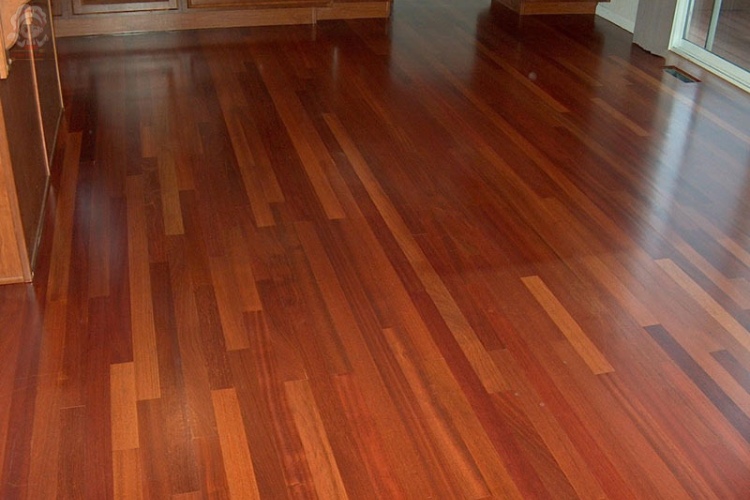
- Jatoba, also known as Brazilian cherry, is a hardwood commonly found in South and Central America. It showcases a captivating brown heartwood and boasts impressive strength and resilience. With proper seasoning and care, the jatoba can retain its natural color. When exposed to light, it may darken.
- It’s important to keep in mind that the grains of jatoba are susceptible to premature damage, as they can split and break when subjected to changes in temperature and humidity.
- On a positive note, Brazilian cherries naturally resist the growth of bacteria and fungi, even in moist conditions. So, if you accidentally leave your wooden spoons in a wet sink, they are less likely to be affected. Additionally, Brazilian cherry’s durability is further enhanced by its ability to resist warping or shrinking when adequately dried after exposure.
1.7. Birch

- Birch is a beautiful wood with a light color that offers both strength and stability. It’s an excellent choice for making high-quality cutting boards and serving platters. If you have birch boards in your kitchen, you probably appreciate how well they hold up to everyday use.
- To keep your birch cutting board in great condition, proper maintenance is essential. Regularly applying mineral oil is important to prevent moisture from getting trapped in the wood’s pores and causing it to warp over time. Additionally, avoid cutting directly on the board, as it can leave marks and damage the surface.
- To keep your cutting board looking its best, simply clean it with soap and water on a weekly basis, making sure to thoroughly dry it before generously applying a layer of mineral oil. This will help maintain the board’s integrity and prevent mold growth. Now, you’re all set to create some delicious meals with confidence!
1.8. Mexican Ebony wood
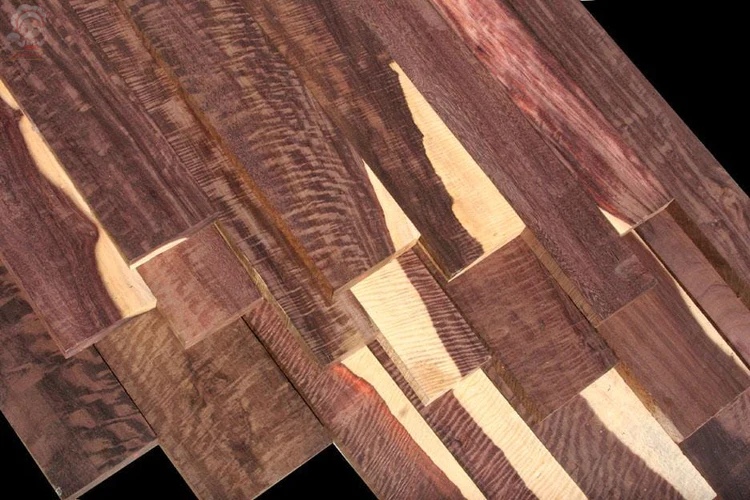
- Mexican ebony is an extraordinary type of wood that comes from the Diospyros tree genus. It is highly regarded for its solid structure, exceptional strength, stunning ebony color, and intricate grain patterns.
- There is a strong demand for exquisite culinary tools made from Mexican ebony. It is a popular choice because its characteristics allow it to resist scratches, damage, high temperatures, and warping or splintering. Additionally, it doesn’t absorb liquids or odors, making it perfect for the best kitchen utensils.However, working with Mexican ebony can be more challenging than working with other types of wood due to its durability.
- Shaping and finishing may require specialized tools and techniques. Furthermore, Mexican ebony is a rare and valuable wood, which contributes to the higher cost of utensils made from it. Nevertheless, the captivating visual appeal of kitchenware crafted from Mexican ebony is undeniable.
1.9. Bloodwood
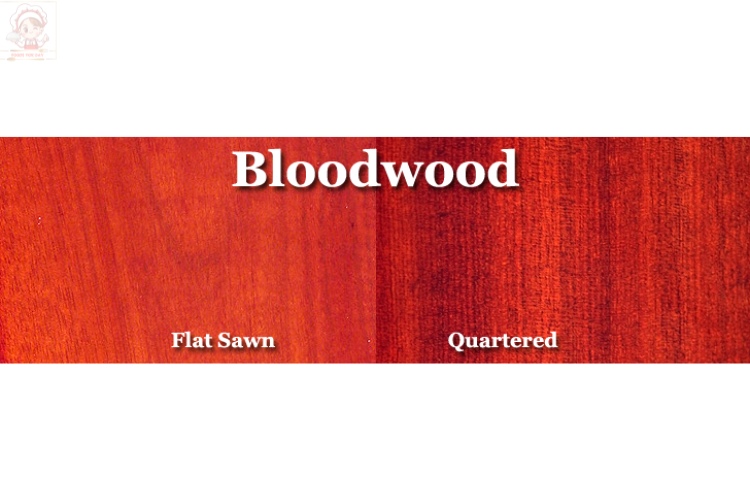
- Bloodwood is a remarkable hardwood known for its incredible strength and stunning deep red color. It is harvested from the Pterocarpus angolensis tree, which is native to southern Africa. The name “Bloodwood” reflects the presence of a pigment called hematoxylin, giving the wood its distinct crimson hue.
- Bloodwood is highly sought-after for a lot of reasons. Its outstanding durability, density, and hardness make it a top choice. You can trust it to withstand dents, damage, and everyday wear with ease. Another fantastic feature is bloodwood, which is non-porous, meaning it won’t absorb liquids or odors. This makes it perfect for use in culinary tools where cleanliness is crucial.
- If you’re on the lookout for kitchenware that combines resilience and visual appeal, Bloodwood is an excellent option. Its unique color and impressive hardness make it a popular choice among discerning chefs and home cooks alike. Bloodwood has high quality, so it has a slightly higher price compared to other wood types.
1.10. Pecan Wood
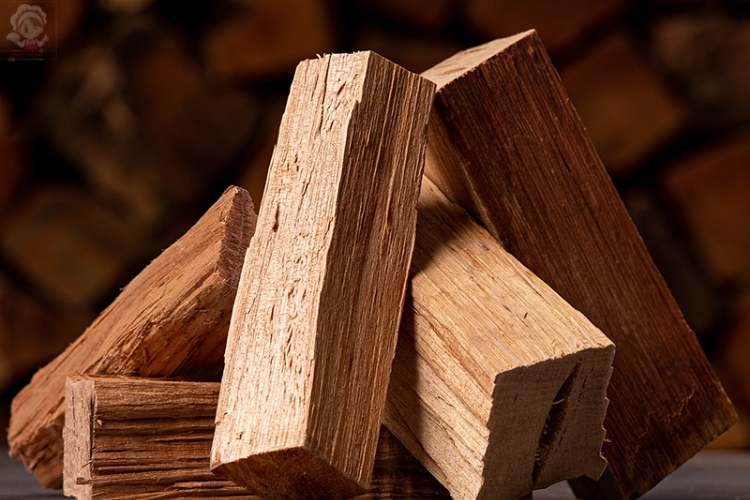
- Pecan wood is a delightful addition to any kitchen. They offer strength and durability and are easy to clean. Using pecan wood is perfect for a variety of cooking tasks, such as deglazing pots or stirring soups and sauces.
- Not only can you effortlessly toss ingredients in a skillet and scrape the sides of the pan, but you can also blend different components together with pecan wood. The pecan tree, belonging to the hickory family, brings versatility and reliability to your cooking experience.
- When it comes to those extended barbecue sessions, pecan wood truly shines. It imparts a unique flavor to meats and burns slowly, ensuring a steady and consistent source of heat. While it shares similarities with hickory, the flavor of pecan wood is milder. It’s undoubtedly an exceptional choice for versatile cooking wood that will elevate your culinary creations.
1.11. Beech Wood

- Chefs and cooks all over the world adore durable beechwood. It not only looks stunning but also provides exceptional functionality in the kitchen.
- Thanks to its impressive resistance to heat, non-reactivity to acidic foods, and overall durability, beechwood emerges as the top choice for crafting cooking spoons. As a hardwood, beechwood excels at creating reliable cooking utensils.
- Beechwood is perfect for multi cooking styles thanks to its resilience and ability to withstand high temperatures. Their exceptional heat resistance ensures they won’t warp or crack, guaranteeing their long-lasting performance and dependability.
1.12. Ashwood
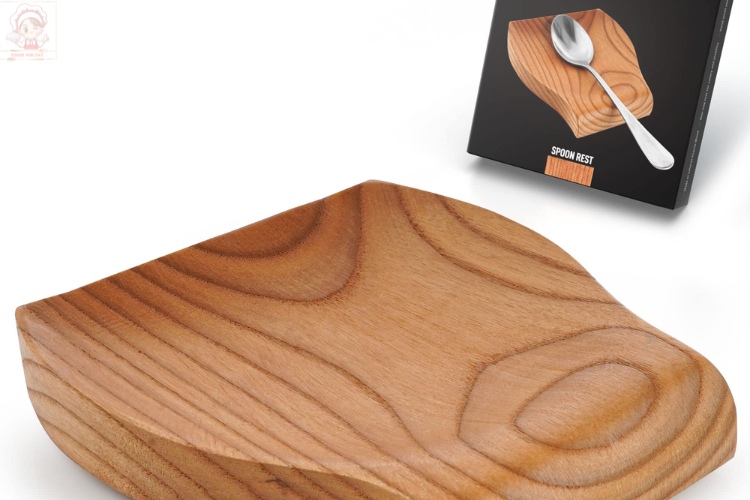
- Ashwood is a versatile hardwood that works wonderfully for kitchen utensils. It’s a fantastic choice because of its strength and durability. Its low moisture content also means it won’t crack or warp easily.
- When it comes to cutting boards, ash wood really shines, as it keeps your knives sharp for longer. So you will not frequently have to sharpen them.
- Furthermore, ash wood is easy to carve, making it perfect for crafting spatulas with flat edges or rounded corners, depending on what you prefer.
1.13. Bamboo
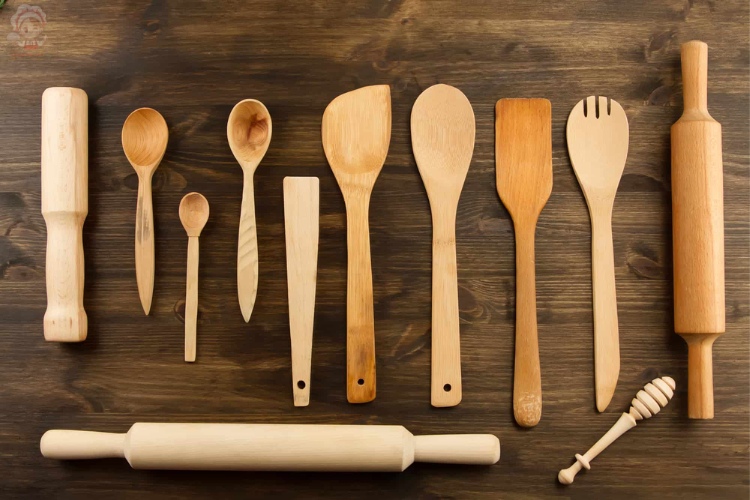
- Bamboo is an excellent choice for making wooden kitchen utensils. It’s a sustainable option that doesn’t contain any harmful substances that could impact your food.
- Bamboo is strong, resistant to heat, and antimicrobial. So when you use a bamboo spoon for cooking, you can be confident in the cleanliness of your food.
- Furthermore, bamboo is smooth and gentle on your pots and pans. It’s an affordable and eco-friendly solution that’s lightweight yet highly durable.
- Although bamboo utensils are sturdy, they can be prone to scratches. If you want your kitchenware to maintain its appearance over time, you can consider staining the bamboo wood.
2. While choosing wood for the best kitchen utensils, factors to consider
Wood is a classic material that has been used for countless years to make kitchen tools. It promotes simplicity in crafting and is a sustainable source. The following are important elements to take into account while buying cooking spoons
Price
The saying “you get what you pay for,” is often true, and it applies to wood as well. Investing in high-quality wood is a good choice because good wood is durable and easy to take care of. After all, who wants to deal with annoying scraping sounds while cooking?
Before purchasing a wooden kitchen utensil, check the quality to ensure it meets your expectations. Remember, “you get what you pay for,” which brings you peace of mind in the kitchen.
Quality
Choosing quality kitchen utensils that are expertly designed and made with durable materials. Be mindful of any signs of poor workmanship, such as excessively sharp edges, handles that feel wobbly, or surfaces that are uneven.
Material
The material used should be given priority. It’s simple for us to become mesmerized by a spoon’s shape and beauty and overlook the importance of understanding its composition. However, this is the crucial factor that directly impacts the lifespan of the spoon.
Functionality
Choose kitchen utensils that are user-friendly, and multi function. When making your selection, give preference to utensils with flexible designs and sizes that make stirring, flipping, scraping, and other cooking tasks effortless.
Safety
Make sure the utensils you select are not only safe and trustworthy but also crafted from food-grade materials that are free from any toxic chemicals or harmful substances.
Maintenance
Take into consideration the cleaning and maintenance needs of the utensils. Look for kitchenware that is simple to maintain and clean, conveniently hand-washed or safely placed in the dishwasher.
3. Which is better for kitchen utensils, softwood or hardwood?
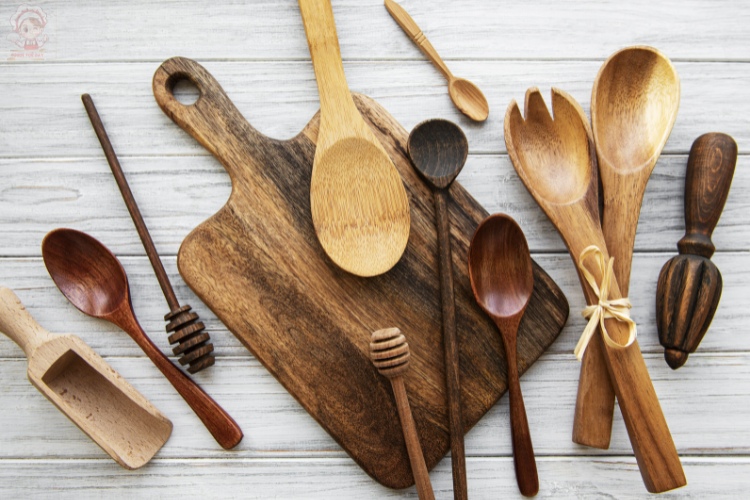
Once you get acquainted with their characteristics and uses, you can easily choose the wood variety that best suits your needs. The dissimilarity between two types of wood does not depend on how hard or soft they are but rather on their grain structure, methods of reproduction, and the way they transport water.
- Hardwoods are highly praised for their strength and ability to withstand decay. They are perfect for frequently used tools like spoons and spatulas because they can resist damage and dents. However, hardwoods may have a higher price and be less flexible when making different types of tools utensils. Their hardness can make shaping them a bit more challenging.
- Softwoods are flexible and easy to work which become a versatile choice for making a wide range of kitchen utensils. They are a wallet-friendly option as they tend to be less expensive than hardwoods. Noting that softwoods are easy to scratch and dents, which can affect their long-term durability.
Nevertheless, we believe that hardwoods are the best choice for your kitchen utensils, and here’s why:
4. Hardwoods are the best for kitchen utensils, aren’t they?

- Outstanding heat resistance – Thanks to their thickness and durability, hardwoods offer superior resistance to high temperatures compared to softwoods. Their ability to withstand heat without burning makes them highly sought after for wooden kitchen utensils.
- Strong and durable – Hardwoods are incredibly sturdy and durable, surpassing softwoods in strength. This exceptional quality expands the range of design possibilities for kitchen utensils. For example, a hardwood spatula with a thickness of 0.12 inches can be used for many years. On the other hand, a softwood spatula used regularly will gradually shrink with each wash. Choosing wooden utensils is a wise decision because wood is a robust material that can handle exposure to water better than other materials.
- Exquisite and captivating – Exotic hardwoods showcase stunning colors and unique grain patterns that enhance their visual appeal. The distinct grain patterns add a touch of charm to the crafted items, making them truly special. They are the perfect choice for creating exceptional kitchenware that can be cherished for generations.
- Long-lasting – Hardwoods are widely used in flooring, furniture, and spoon-making due to their ability to withstand wear, scuffs, and scratches. They are a dependable choice for culinary tools that are built to last.
- Easy maintenance – Hardwoods are resistant to cracking and scratching, making them easy to maintain. Cleaning them is a breeze, requiring minimal effort to keep them in great condition.
5. FAQ about best type of wood for cooking tools
Q: What is the best wood for cooking utensils that are non-toxic?
A:If your focus is on finding the best wood for cooking utensils that are non-toxic, then bamboo or beech options certainly offer the desired utility, durability, and safety.
Q: Is teak or bamboo better for cooking utensils?
A: When considering which wood is better for cooking utensils, both teakwood and bamboo are capable of withstanding high heat. However, teakwood surpasses bamboo in one aspect: its exceptional resistance to warping. If you desire kitchenware that remains sturdy and unaffected while stirring sauces, teakwood might be the ideal option for you.
Q: How long should you keep wooden utensils?
A: Specifically, Her World recommends replacing your wooden utensils every five years or so. One clue that it’s time to replace your spoon is if it has any cracks in it, as microbes and bacteria can live in them, raising the risk of spreading germs.
I’m Elva, a housewife with a strong passion for cooking who has improved her cooking skills over time. Thanks to my comprehensive knowledge of culinary techniques and my ability to prepare a wide range of meals, I fill my house with warmth and mouthwatering flavors. I am aware that cooking is an expressive activity that goes beyond simply preparing food for my loved ones.
